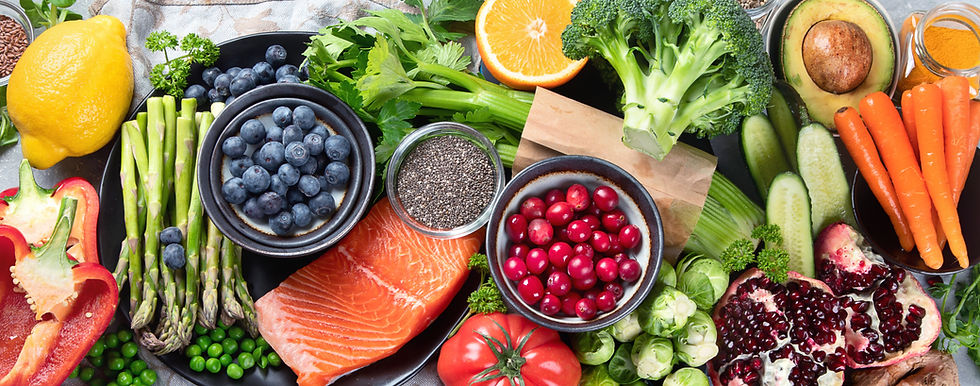- Helen Gowers
- Oct 10
- 5 min read

We have all experienced biscuits or a bar of chocolate calling to us from the kitchen. Food noise is the persistent, unwanted, mental chatter or intrusive thoughts about food (1). It’s initiated by external cues, emotional triggers or hormone imbalances rather than physical hunger and when severe, can lead suffers to be completely preoccupied with food, or more usually specific ultra-processed foods (UPF), for much of their day. UPF are industrial formulations of ingredients designed to be hyperpalatable and heavily marketed, according to the NOVA classification (2). Whilst food noise may result in overconsumption and weight gain, it can also affect people of normal weight.
GLP-1s seem to reduce food noise
Early adopters of GLP-1 medication such as Ozempic, Wegovy and Mounjaro, reported a dampening of their food cravings. These drugs work on the hormones which control appetite and satiety signalling in the gut making people feel less hungry. They also slow digestion, glucose absorption and the speed food leaves the stomach giving a feeling of fullness. But it’s their ability to interfere with the area of brain which governs food seeking behaviour and reward, essentially how the sight, smell and sound of food or its packaging translates into an urge to consume irrespective of whether we are hungry, which offers relief for those feeling addicted to certain foods (3).
Ultra-processed Food Use Disorder
An international group of experts are lobbying the World Health Organisation to recognise Ultra-processed Food Use Disorder (UPFUD) as a diagnosis (4). The group argue that the body of evidence from psychiatry, nutrition, neuroscience and substance use has grown exponentially in recent years and demonstrates some people become addicted to UPF in a similar way to alcohol. They estimate as many as 14% of adults (5) and 15% of children are affected globally (6).
Dopamine Reward Pathway
Dopamine is a neurotransmitter in the reward centre of the brain. It is designed to encourage behaviours essential for survival by triggering pleasurable feelings following a stimulus. For example, dopamine released in response to breast milk motivates the infant to want to continue suckling (7). Interestingly, very few natural foods contain this mix of sugar and fat, milk, nuts and seeds being the main ones. UPF manufacturers fine tune the ratio of fat, sugar and salt in their products to achieve this Bliss point making them irresistible and driving up consumption (8).
Eating highly refined carbohydrates creates a large spike in dopamine delivering an exaggerated response or ‘high’. However, to protect itself from over stimulation the neurone will down regulate its receptors. This means more of the food is required to create the same pleasurable sensation encouraging further consumption and in larger amounts and setting up an addictive feedback loop which is hard to break.

It takes several weeks or months to reset the receptors so that the original response is restored (9). However, many food addicts find that a single repeat exposure can reactivate the compulsion again which may take weeks to get under control, making abstinence the only sustainable solution.
Impact of poor sleep
Lack of sleep changes the balance of dopamine in the brain to compensate for fatigue. It also affects the prefrontal cortex in the brain responsible for self-control and impulsive behaviour making indulgence in hyperpalatable, carbohydrate rich foods much more likely. This is compounded by disruption to the levels of hunger hormone ghrelin and satiety hormone leptin which also encourages seeking out these foods (10).
How to silence food noise
Understanding how all these factors impact cravings can be very helpful and it is reassuring to know that it is not down to lack of will power or self-control. However, there are several ways to reduce food noise and cravings without resorting to weight loss medication.
Diet
Eat real food. Eating food made from unprocessed ingredients, rich in protein and fibre stimulates natural GLP-1 and satiety hormones reducing hunger and keeping you feeling full. Reducing frequency of snacking especially on UPF helps to stabilise insulin levels and reduce hunger pangs.
Remove temptation
Removing these foods from reach by not buying them or keeping them out of sight makes it easier. Even hearing people opening the packets can trigger the unconscious mind making them instantly desired. Having a meal plan and cooking in batch will ensure nutritious meals are ready to eat at the end of a busy day when temptation to snack will be heightened.
Sleep
Having a bedtime routine and reviewing sleep hygiene to ensure at least 7 hours quality sleep each night is key. Avoiding screen time or work in the evening, enjoying a bath or book, ensuring the room is cool and dark all help to encourage good quality sleep. Caffeine or alcohol in the evening are big sleep disrupters for some people.
Exercise
Generally, exercise is an excellent way to deal with stress and provide a distraction from eating. Find something you enjoy like gardening, dancing or walking in nature and do lots of it. There is evidence that exercise will boost GLP-1 hormones too.
Build coping strategies
If you are reaching for food as a way of coping with emotions, then you need to work on developing alternative strategies. Hobbies, or distractions such as going for a walk or having a cup of tea can be helpful to ride the wave of a craving which usually lasts only 15 seconds. Looking for ways to unpack stressful events and calmly process them without resorting to food such as regular exercise, mindfulness or talking to friends can also make a big difference.
Be kind to yourself
Persistent food noise can be relentless. If you have been living with it all your life, it can be a relief to find you are not alone. Joining groups where you can share your experiences and learn from others can be very supportive. Creating new routines takes time and effort so be grateful for each step in the right direction and treat each digression as a learning opportunity. Focus on progress rather than perfection!
References
1) Dhurandhar, E.J., Maki, K.C., Dhurandhar, N.V. et al. Food noise: definition, measurement, and future research directions. Nutr. Diabetes 15, 30 (2025).
2) Monteiro CA, Cannon G, Moubarac JC, Levy RB, Louzada MLC, Jaime PC. The UN Decade of Nutrition, the NOVA food classification and the trouble with ultra-processing. Public Health Nutr. 2018 Jan;21(1):5-17.
3) Hayashi, Daisuke, Caitlyn Edwards, et al. 2023. "What Is Food Noise? A Conceptual Model of Food Cue Reactivity" Nutrients 15, no. 22: 4809.
4) LaFata, E.M., Allison, K.C., Audrain-McGovern, J. et al. Ultra-Processed Food Addiction: A Research Update. Curr Obes Rep 13, 214–223 (2024).
5) Praxedes DRS, Silva-Junior AE, Macena ML, Oliveira AD, Cardoso KS, Nunes LO, et al. Prevalence of food addiction determined by the yale food addiction scale and associated factors: a systematic review with meta-analysis. Eur Eat Disord Rev. 2022;30(2):85–95.
6) Yekaninejad MS, Badrooj N, Vosoughi F, Lin CY, Potenza MN, Pakpour AH. Prevalence of food addiction in children and adolescents: a systematic review and meta-analysis. Obes Rev. 2021;22(6):e13183.
7) Gearhardt AN, Schulte EM. Is food addictive? A review of the science. Annu Rev Nutr. 2021;41:387–410.
8) Dario Dongo Food Times: The Bliss effect in ultra-processed food formulation August 25, 2025 (accessed Oct 2025)
9) Evita Singh The Ohio State University Health & Discovery: Health. Dopamine Fasting, does it work? 2/1/2025 (accessed Oct 2025)
10) Society for Neuroscience. "One Sleepless Night Increases Dopamine In The Human Brain." ScienceDaily. ScienceDaily, 21 August 2008. (accessed Oct 2025)







